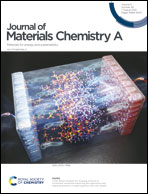Synergistic effects of nanodiamond modified separators toward highly stable and safe lithium metal batteries†
Abstract
Lithium (Li) metal anode has attracted much attention due to its extremely high specific capacity and very low redox potential. However, the serious safety issues and the cycling stability problems induced by Li dendrite growth limit its practical application. Here, a novel and safe separator is developed by spraying nanodiamond particles on a commercial separator. Our nanodiamond modified separator simultaneously provides favorable electrolyte affinity for regulating Li+ distribution, high Young's modulus (over 11 GPa) against Li dendrite growth and excellent thermal diffusion ability to provide a homogeneous thermal environment for Li deposition. Especially, in situ observations and temperature probing further suggest that the modified separator effectively avoids the uneven Li deposition at the localized high temperature spot. Benefiting from the synergistic effects of the modified separator, high-performance Li metal batteries with dendrite-free Li metal anodes are achieved. Notably, an ultrahigh capacity retention of over 90% is achieved after long-term cycling for 1400 cycles in an LiFePO4|Li cell. Our facile and efficient strategy opens up an opportunity for highly stable and safe Li metal batteries by separator engineering.



 Please wait while we load your content...
Please wait while we load your content...